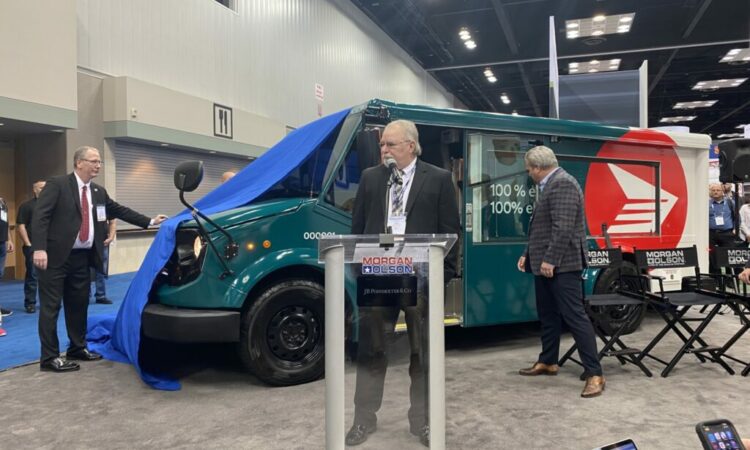Canada Post employees can look forward to added comfort and a quieter ride, with the Morgan Olson C250 electric cargo van that will play a central role in corporate sustainability efforts.
“It’s been a long time in the making,” said Larry Palmer, Morgan Olson’s vice-president – sales and marketing, who was part of the team that brought the manufacturer’s first postal truck to market almost 40 years ago.
The green truck – in both a literal and figurative sense – made its debut at the Work Truck Show in Indianapolis, complete with Canada Post branding and “000001” unit number.
Canada Post employees can look forward to added comfort and a quieter ride, with the Morgan Olson C250 electric cargo van that will play a central role in corporate sustainability efforts.
“It’s been a long time in the making,” said Larry Palmer, Morgan Olson’s vice-president – sales and marketing, who was part of the team that brought the manufacturer’s first postal truck to market almost 40 years ago.
The green truck – in both a literal and figurative sense – made its debut at the Work Truck Show in Indianapolis, complete with Canada Post branding and “000001” unit number.
“It took years of collaboration,” said Alexandre Brisson, Canada Post’s vice-president – operations transformation. “This is the kind of vehicle we need in order to meet our Canada Post sustainability ambitions.”
About 7,000 of the units will be in service by 2030, representing half of the Crown Corporation’s existing fleet, with the first models to be deployed in B.C. and Quebec. The entire Final Mile fleet is to be electric-powered by 2040.
“We’re committed to achieving net zero-emissions by 2050, and electrifying our fleet will be key to that,” Brisson said. “The all-electric demonstration vehicle we unveiled today is a symbol of our ongoing innovation and the important steps we’re taking now to create a zero-emission fleet by 2040 for various vehicle classes, including right-hand drives.”
Replacing and upgrading the LLV
The new models will replace the long-serving Long Life Vehicles (LLVs), many of which have been in service for 15-20 years.
The upgrade is also important to address the changing nature of deliveries, with growing parcel volumes rather than letters. “The fleet renewal is also about bringing in bigger trucks or bigger cabs so we can manage the space,” Brisson told TruckNews.com.
“We have been deploying the ICE version of this vehicle to some of the most rural and remote parts of Canada,” added Steve Clark, director of fleet at Canada Post.
“It’s a big step forward and all about safety,” Brisson said. “The feedback so far from employees was very good – and obviously it’s quite an upgrade.”

Features of the C250 include things like four-wheel drive, over-hung side mirrors positioned to clear mailboxes on approach, and the all-important HVAC enhancements that will be welcomed by drivers who tend to travel with windows down.
“The heated seats, heated mirrors and steering wheels are like winning the lottery,” Clark said.
Visibility is further enhanced by crossview mirrors, as well as rearview and blindside cameras that are activated by turn signals.
A cargo management system engineered by Masterack (a Morgan Olson partner) also includes slides, rollers and pullout trays to bring products to drivers inside the vehicle.
ICE and electric
The ICE-powered 250 is already rolling off the production line in Ringgold, Virginia.
Electric rollouts, meanwhile, will also require upgrades to fleet facilities to incorporate charging. The first depot using all-electric delivery vehicles will be unveiled tomorrow in Nanaimo, B.C.
Many Canada Post depots are in tightly constrained urban centers, and will need to be reconfigured to offer space for charging. That’s on top of the electrical infrastructure itself.
“We have every shape, every color of facilities,” Brisson said. “It’s a big job. This electrification over time is certainly about the vehicles, but it’s also hugely about the whole real estate piece.”


